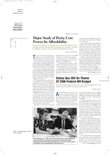As part of the effort of the House Energy and Commerce Committee to reauthorize NIH for the first time since 1993, Chair Joe L. Barton (R-Texas) issued an initial draft of the as-yet-unnumbered legislation in July, and further details of the bill were released during the August recess. The committee has oversight of NIH as part of its jurisdiction over the Department of Health and Human Services (HHS).
Barton said a reorganization—which current NIH Director Elias Zerhouni, M.D., and predecessor Harold Varmus, M.D., have championed—was particularly needed now to take better advantage of the institution's explosive growth, including the doubling of its budget from 1999 to 2003. The growth has since slowed, and the institution's current $27.9 billion budget is expected to rise less than 0.5 percent in the next fiscal year (see
page 1).
“We're not just going to turn a blind eye and say business as usual is OK, because the dollars are too big, and the consequences are too big,” Barton said at a July 19 Energy and Commerce Committee hearing on the reorganization. “Quite frankly, the assets at the disposal of NIH are significant. If we can channel them in a more comprehensive and coordinated fashion, we're going to do great deeds in the years ahead.”
As additional details on the reorganization bill were released by Barton, APA and other health care advocacy organizations said the legislation appears more favorable, but work remains.
The latest details added to the draft legislation “answered some of the questions that had been brought up in the committee about the extent of the director's authority and about consolidation of some offices under the director that needed further thought in legislation,” said Lizbet Boroughs, deputy director of APA's Department of Government Relations.
The draft legislation would consolidate the NIH institutes and centers into two divisions, with one focused on specific diseases or organs and the other focused on basic research. Each institute and center would maintain the same structure and function as now, but all would set aside a percentage of their budgets for a common fund for use in projects that overlap the divisions. The NIH director, the two divisions, and a third division that coordinates overlapping research would have separate budgets.
Under the draft bill, the NIH director could award research grants“ independent of the agency's institutes and centers.”
The NIH director, following approval of the HHS secretary, would have authority to establish or eliminate institutes and centers, with the total number of institutes and centers capped at 24, down from the current 27 (see box on
page 20). The reduced number stems from the planned consolidation of some of the centers that provide support functions but are not involved in research.
APA is concerned that the reorganization would likely result in the consolidation of the National Institute on Drug Abuse with the National Institute on Alcohol Abuse and Alcoholism. That consolidation may result in research on drug abuse overshadowing the research on alcohol abuse, according to some researchers.
APA and other health-related advocacy organizations, such as the Association of American Medical Colleges, are concerned that the bill creates an NIH director with excessive authority over key administrative offices that oversee human research protection and the peer-review process. In addition, a powerful director, according to the critics, might change or cut research grants at will.
“What is the point of having specific allocations for specific institutes if the NIH director can change all of those allocations?” Boroughs said.
The bill's supporters said the reauthorization language expands and enhances the authority of the NIH director over making budget allocations, consolidating the institutes and centers, and matching the NIH's research priorities with the burden of disease.
APA and other advocates have written Barton to seek clarification of the parameters of the NIH director's authority under the draft legislation because the initial draft had provided few checks on the position, Boroughs said. Many health care advocates who urge more limitations on the director are admirers of the current director, so the issue is well beyond a concern with any specific director.
Concerns over increases in the director's authority at the expense of the directors of the 27 institutes and centers focus on the inability of any one medical professional to have sufficient expertise to make budget and grant decisions for the wide variety of highly specialized areas under study. The current organization allows each institute and center director, who is more familiar with the complicated work in different fields of medicine and who knows the promise of the science in that particular field, to prioritize the research he or she oversees.
The revised draft legislation left unchanged the authority of directors of the institutes and centers to oversee their research programs. The bill specifies that the NIH director will “ensure that scientifically based strategic planning is implemented in support of research as determined by the institute and center directors.” The NIH director will lead“ program coordination across institutes and centers, to ensure that the research portfolio of NIH takes advantage of collaborative, cross-cutting research.”
The draft legislation also specifies that an advisory panel would recommend funding of “trans-NIH research projects” and that the NIH director would not have additional grant-making authority. Instead, the director would allocate funding to the institutes and centers to carry out the trans-NIH research activities identified by the appropriate division.
“We're not just going to turn a blind eye and say business as usual is OK, because the dollars are too big, and the consequences are too big.”
The legislation also expands the “public process” aspect of any reorganization of the NIH institutes and centers, which was advocated by committee members of both parties in the July hearing on the initial draft of the bill.
Barton has told health advocates that the House Energy and Commerce Committee plans to mark up the legislation sometime this month. The Senate has no plans to consider an NIH reauthorization bill.
